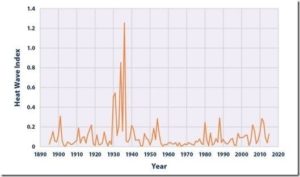by Clyde Spencer, Sep. 6, 2019 in WUWT
Abstract
Tmax and Tmin time-series are examined to look for historical, empirical evidence to support the claim that heat waves will become more frequent, of longer duration, and with higher temperatures than in the past. The two primary parameters examined are the coefficient of variation and the difference between Tmax and Tmin. There have been periods in the past when heat waves were more common. However, for nearly the last 30 years, there has been a reversal of the correlation of increasing CO2 concentration with the Tmax coefficient of variation. The reversal in differences in Tmax and Tmin indicate something notable happened around 1990.
Introduction
There was much in the press this Summer about the ‘global’ heat waves, particularly in France and Greenland. For an example of some of the pronouncements, see here. The predictions are that we should expect to see heat waves that are more frequent and more severe because of Anthropogenic Global Warming, now more commonly called “Climate Change.” The basis for the claim is unvalidated Global Climate Models, which are generally accepted to be running to warm. The simplistic rationale is that as the nights cool less, it takes less heating the next day to reach unusually high temperatures. Unfortunately, were that true, that would lead one to conclude that heat waves should never stop.
…

Fig. 1. U.S. Annual Heat Wave Index, 1895-2015
https://www.epa.gov/climate-indicators/climate-change-indicators-high-and-low-temperatures
If the predictions of worse future heat waves were valid, one might expect to be able to discern a change occurring already, inasmuch as it is commonly accepted that Earth has been warming at least since the beginning of the Industrial Revolution
